Lesson: Trees, Shrubs and Herbs
Trees are perennials . "Perennial" means they live for many years. How long do trees live? Some live tens, while others live hundreds of years. There are long-lived trees on our planet, they live for more than a thousand years. Consider a table of the life span of some trees.
Long-lived is Sequoia, its life expectancy is more than a thousand years.
It takes many years for a tree to become big and powerful. How old is a tree, you can find out by annual rings on saw cut. Every year the tree grows, forming a new annual ring. Carefully consider the annual rings, they encode the history of the entire life of the tree.

All trees have a common structure. They have roots, a hard trunk covered with bark, branches form the crown of the tree. Trees differ in trunk thickness, crown shape and color, bark pattern. Consider the drawings and identify the trees by the bark.

![]()

And trees differ from each other in leaves, flowers, fruits, seeds. They are of different sizes, shapes and colors. Consider the structure of the leaves.


A leaf consists of a leaf blade and a petiole. simple leaves have one sheet. Linden, oak, aspen have such leaves.


compound leaves consist of several leaf plates, each of which has its own petiole. Such leaves are found in chestnut, mountain ash, ash.
Sometimes trees of the same species grow in one place. For example, only birch, oak, spruce or aspen; such places have their own names.


Rice. 13. Oak grove or oak forest ()
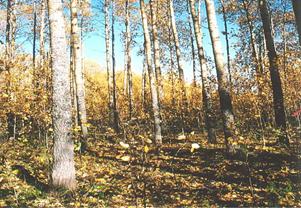


Like all plants, trees start to bloom in spring. Willow and alder are the first to bloom, followed by birch, mountain ash, and maple. Oak is the last to bloom . In place of flowers, fruits are formed. Consider the pictures and identify the trees by their colors.




How does a person use wood? ? Wood- this is the inner part of the tree without bark. From wood, people build houses, make furniture, paper, use it as fuel and make various things.
shrubs are perennial plants. They live 10-20 years. Shrubs do not have a main trunk, they have several hard trunks covered with bark. Let's get acquainted with some representatives of this group.
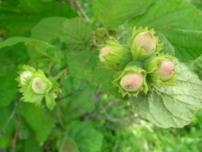
The name comes from the word "bream". The round leaves of this shrub are shaped like a fish. Hazel fruits are nuts, it is edible. The second name of the shrub is hazel.
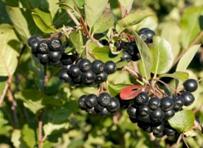
Rice. 26. Chokeberry ()
Shrub with black fruits. The fruits are edible and have medicinal properties. The second name of this shrub is Aronia.

This shrub gets its name from the color of the fruit. The fruits are not edible.
Herbaceous plants do not have a hard stem, their stem is soft, juicy and green. Among herbaceous plants, there are also perennials.
These include Tansy. This plant is easy to recognize yellow flowers and leaves similar to rowan leaves.

Burdock or burdock. The fruits of this plant have hooks, it is worth at least one hook to catch on the hair of an animal or a person’s clothes, and it is almost impossible to tear them off. No wonder there is an expression: "Stuck like a burdock." And thanks to burdock, a discovery was made - Velcro. It was invented in 1948 by Swiss engineer Georges de Mestral, who saw burdock seeds attached to his dog's fur.

Among herbaceous plants there are also annual plants that live for one year. In the spring they germinate from seeds, in the summer they bloom, in the fall they give fruits with seeds and die off.
Shepherd's purse belongs to annual herbaceous plants. The fruits of this plant are shaped like a shepherd's bag.

Quinoa. The leaves of this plant are covered with silvery hairs, so they seem to be sprinkled with flour.

Mokritsa. The plant got its name because it is always wet even in dry weather. Because of the flowers resembling stars, the plant received a second name - Starfish.

Woodlice, quinoa and shepherd's purse are wild plants that have received another name - weeds or weeds. They grow in fields and gardens along with cultivated plants. Weeds absorb a large number of water and nutrients, thereby drowning out cultivated plants and reducing yields.
Weeding is one way to control weeds.
In the next lesson, the topic "Deciduous and coniferous trees" will be considered. In the course of the lesson, we will divide the trees into two groups and find out their distinguishing features.
1. Samkova V.A., Romanova N.I. The world around 1. - M .: Russian word.
2. Pleshakov A.A., Novitskaya M.Yu. The world around 1. - M .: Education.
3. Gin A.A., Faer S.A., Andrzheevskaya I.Yu. The world around 1. - M .: VITA-PRESS.
1. Festival of pedagogical ideas "Open Lesson" ().
1. What is the difference between trees, shrubs and herbs?
2. What trees and shrubs grow on your school grounds?
3. What plants are called annuals, biennials and perennials?
4. * Tell us how the plant grows and develops. Number the drawings.

Higher plants (which include all plants except algae) have many different life forms. Among them there are three most pronounced and well-known life forms. These are trees, shrubs and herbs.
Trees, shrubs and herbs are most diversely represented in angiosperms. It is angiosperms that have a more complex structure and grow in many habitats. The various life forms of plants are the result of their different ways adaptation to environmental conditions.
Trees have a woody main stem called trunk. The remaining stems of the tree are called its branches and form crown tree. Trees are characterized by high size (usually tens of meters) and long life (usually hundreds of years).
The trunk of a tree is preserved throughout its life.
In turn, the trees are divided into coniferous and deciduous. Conifers are gymnosperms. At coniferous trees leaves are modified into needles, which are called needles. Usually conifers are evergreen trees, as their needles do not fall all in a certain season. Of course, in such trees there is a change of foliage. But each needle falls in its own time, regardless of the others.
Modern deciduous trees are angiosperms. Their leaves have the appearance of a wide plate. Many deciduous trees are deciduous, that is, their entire foliage falls for the winter. However, even among deciduous trees there are evergreens, usually where there is no pronounced change of seasons.
shrubs, as well as trees, have woody stems. However, their main difference from trees is the absence of the main stem, i.e. the trunk. He certainly is, but usually has small size and is located near the ground. Numerous stems grow from the trunk. Also, unlike trees, the stems of shrubs do not live their entire lives, but can die off and be replaced by new ones. Most often shrubs are much fewer trees. However, among them there are quite high ones (for example, hazel or lilac). Also shrubs live less than trees. The average life expectancy of shrubs is only 10-20 years.
In nature, thickets of bushes form near forests or as undergrowth in forests, if they have enough sunlight there.
Herbs, or herbaceous plants, usually do not have woody stems. Their stems are soft, often green and thin. Herbs are divided into annuals, biennials and perennials.
Annual grasses live less than a year, in the most favorable seasons for themselves. For example, from spring to autumn. During this time, they manage to grow from the seed, bloom, give fruits and seeds. After which they die.
Biennial grasses in the first year of life give only vegetative parts (roots, stems and leaves). For the winter, the above-ground green part of the plants dies off. But roots and underground stems remain in the ground, more often modified, with a supply of nutrients. In the second year, green stems and leaves develop again in spring. However, besides them, there are more flowers. After pollination, fruits and seeds ripen. When the plant bears fruit, it dies off completely.
Perennial grasses in temperate climates leave only their underground parts for the winter. These can be roots, rhizomes, bulbs, tubers, etc. Every spring, an above-ground shoot (consisting of stems, leaves, flowers) grows from the underground buds of the plant. However, in the tropics, in many perennial grasses, the above-ground shoots do not die off annually and often reach enormous sizes for grasses. For example, a banana is a herbaceous plant that reaches a height of more than 10 m.
Among all known plants, various shrubs occupy a special place. This is due to their intermediate position between grasses and trees, as well as their extremely important agricultural value. In this article, we will consider the signs that allow us to determine that a plant is called a shrub, which has its own characteristics. characteristics. We will also make sure of their diversity.
Possible plant varieties
Since the modern variety of plants is extremely large, their classification is necessary. Not only by strictly defined taxonomic units that help determine the location in the system of the organic world, but also by appearance plants, that is, according to its life form.
The most common system is the classification according to Serebryakov I. G., adopted in 1964. According to her, all plants are divided into the following groups:
- This category includes trees, shrubs and shrubs.
- Semi-woody - semi-shrubs and semi-shrubs.
- Ground herbs.
- Water herbs.
The basis of such a classification is the length of the skeletal axes of the plant and the duration of its entire life.
According to Serebryakov, a shrub is a plant that has several wooden stems. In general, this is true and is a generally recognized feature of such plants. However, there are some subtleties in the structure of shrubs.

A shrub is a plant that has...
To answer the question of what is called a shrub, we first give a few simple well-known examples of such plants. It:
- lilac;
- juniper;
- Rowan;
- bird cherry;
- sea buckthorn;
- rosehip and others.
Now that the visual representation of these plants has already been clearly formed in the mind, it is possible to give a definition from a scientific point of view.
A shrub is a plant that initially has one wooden trunk, but from a very young age acquires several more of the same trunks, formed from dormant buds. That is, there are a lot of trunks in total.
An adult shrub is a plant that has several equivalent wooden trunks, among which it is impossible to distinguish the main one. At the same time, the basal rosette remains the only one for all stems. These plants can vary considerably in height.
So, for example, bird cherry is a fairly tall shrub that in many ways resembles a real tree. A is a very low height of which does not exceed 5 cm.

The main distinguishing features of shrubs
We can summarize all of the above and highlight a few of the main distinguishing features characteristic of shrubs:
- The presence of initially one trunk of a wooden type.
- Over time, the formation of many woody stems, which become completely equivalent for the whole plant.
- The presence of one basal rosette for all stems.
- Various sizes and adaptations for life.
- Less term life cycle compared to trees.
- They inhabit almost all climatic zones of the Earth, from the subtropics to the tundra.
- All trunks are renewed over time, which occurs due to the death of old ones and the growth of new ones.
Thus, a shrub is a plant that has a number of hallmarks, allowing them to be isolated from both grasses and trees.
Shrub classification
Like all other natural forms of plants, shrubs have their own classification. According to her, they are of the following types:
Let's take a closer look at each group and give examples to get an idea about these plants.

Shrubs with lignified elongated shoots
What types belong to this group, we have identified above. Now we briefly describe each of them and give examples.
- An upright shrub is a plant that has 1 (one) woody stem and several lateral branches growing vertically straight. These are transitional forms between shrubs and trees. Most species belong to this group. Examples: astragalus, bird cherry, mountain ash and others.
- Real shrubs. These are those in which the aerial part of the shoot is less durable and thinner than the underground xylopodium. Examples: wild rose, barberry, bamboo, sea buckthorn, snowberry, lilac and others.
- Creeping shrubs are those in which the stems branch and spread along the ground, taking root in some places. Examples: mountain alder, juniper, willow.
- Lianoid shrubs - like liana trees, they use other trees to grow. The difference is that the thickness of the trunk of shrubs is much less. Examples: honeysuckle, lemongrass and others.
It is obvious that this type includes the largest number species from all currently known shrub forms.
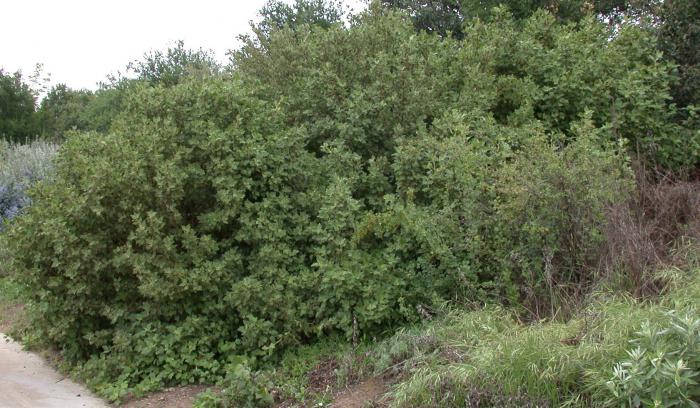
Shrubs with short shoots
A similar shrub is a plant that has a single wooden stem with very frequent rosettes of leaves and very short internodes. Therefore, from the side they look more like lush grasses.
A few types of heather, snakewort, erica, rhododendron and some others can serve as examples. Habitat - Australia and Oceania.
An interesting representative of this family, known in Australia as the profusely flowered nuytsia. It got its name for the beautiful bright orange and yellow flowers that bloom right in time for the New Year.

leafless shrubs
These include several families of cacti. Their thick fleshy stems serve to store water, and the leaves are practically reduced, transforming into needles to reduce the evaporating surface. That is why these shrubs got such a name. The place of growth is obvious - desert areas and typical deserts.
Examples are species of the genus prickly pear. In height, these bushes reach four meters, the flowers are bright yellow or red. This also includes species of the genus Euphorbia, which are used by people for a variety of purposes.
In different parts of the world, sometimes dissimilar cultures are called mint, which are connected by belonging to the mint family and amazing spicy-tasting qualities, which no other garden or wild plant has anymore.
Today, a little more than 20 types of mint are widely distributed, used both in cooking and in folk and official medicine. Healers and scientists of antiquity had experience in the use of this plant material. The benefits of mint for the body were mentioned in their writings by Avicenna and Hippocrates, who called for headaches and indigestion, fever and mental illnesses to be treated with drugs based on mint.
In Russia, mint has long been considered one of the favorite types of spicy greens. Back in the 19th century, in addition to local wild species, in gardens and pharmaceutical gardens one could see cultivated plantings of this plant, and having many useful properties and with a minimum of contraindications, mint leaves, as in the photo, were already collected and used to make mint lozenges, fragrant water, tinctures and soothing herbal teas.
What is the use of mint and is there any harm from taking funds based on it? Were the doctors of the past right, and what do the latest studies on the composition of the herb say?
What is useful mint for the body?
 The modern possibilities of medicine and biotechnology have stepped far ahead compared to the times of Avicenna and even the real prototype of Dr. Watson, who probably recommended mint tea to his patients more than once in dank London.
The modern possibilities of medicine and biotechnology have stepped far ahead compared to the times of Avicenna and even the real prototype of Dr. Watson, who probably recommended mint tea to his patients more than once in dank London.
But even today, experts are unanimous - mint, namely the leaves and stems of the plant, collected before and during flowering, is a powerful remedy for many disorders and diseases.
Useful properties of mint depend on the composition of plant raw materials, which acquires the greatest value at the time of reaching a high concentration of mint essential oil - menthol, at the time of collection, which is from 2.5 to 6% of the mass of leaves or inflorescences. It is this substance that determines the taste, aroma of the herb, and is also the basis of the beneficial properties of mint, for example, its excellent bactericidal ability.
 At the same time, the calorie content of grass is extremely low and amounts to 70 kcal. Of 100 grams of harvested mint, 3.75 grams are proteins, 6.89 grams are carbohydrates, and only 0.94 grams are fats. In addition, herbal medicinal raw materials contain quite a lot of dietary fiber and valuable organic acids, vitamins and mineral salts.
At the same time, the calorie content of grass is extremely low and amounts to 70 kcal. Of 100 grams of harvested mint, 3.75 grams are proteins, 6.89 grams are carbohydrates, and only 0.94 grams are fats. In addition, herbal medicinal raw materials contain quite a lot of dietary fiber and valuable organic acids, vitamins and mineral salts.
- The vitamin composition includes compounds indispensable for the human body: A, B1 and B2, B3, B6 and B9, C and PP.
- Macroelements are represented by calcium, phosphorus and sodium, potassium and magnesium.
- The micronutrients in mint herb are manganese, zinc, iron, and copper.
In addition to menthol, the benefits of mint for the body depend on the presence in the raw materials of substances such as esters, tannins, natural bitterness, phytoncides and flavonoids.
The benefits of mint for the body in folk and traditional medicine
 Peppermint is involved in therapy and preventive measures aimed at combating many diseases. Preparations containing menthol or mint herb have a calming, analgesic, vasodilating and anti-inflammatory effect. Mint is prescribed as a safe diaphoretic, bactericidal and analgesic for diseases accompanied by fever, local pain and irritation of the mucous membranes of the nasopharynx and oral cavity.
Peppermint is involved in therapy and preventive measures aimed at combating many diseases. Preparations containing menthol or mint herb have a calming, analgesic, vasodilating and anti-inflammatory effect. Mint is prescribed as a safe diaphoretic, bactericidal and analgesic for diseases accompanied by fever, local pain and irritation of the mucous membranes of the nasopharynx and oral cavity.
Essential oil from mint leaves with almost no contraindications, but with a lot of useful properties, as in the photo, in combination with other plant components, effectively fights rhinitis, stomatitis and pharyngitis, manifestations of tonsillitis and other seasonal colds. Also, mint grass is used to treat inflammation of the genitourinary system, digestion and liver. Fresh mint in the composition of dishes and drinks not only improves their taste, but also actively increases appetite, relieves such unpleasant symptoms as heartburn, nausea and increased gas formation.
 What mint is useful for the circulatory and nervous system is a stimulating tonic effect.
What mint is useful for the circulatory and nervous system is a stimulating tonic effect.
On the one hand, mint-based preparations can effectively calm and relieve stress, and on the other hand, it speeds up mental activity, helps the body overcome migraines and insomnia.
 It is thanks to such extensive beneficial properties that mint is widely used in traditional medicine and is included in the compositions of well-known, tested and new medicines. Such medicinal preparations using plant materials have analgesic, choleretic, antispasmodic and antimicrobial effects, they actively soothe, stimulate digestion and the activity of the endocrine glands, and have a beneficial effect on smooth muscles.
It is thanks to such extensive beneficial properties that mint is widely used in traditional medicine and is included in the compositions of well-known, tested and new medicines. Such medicinal preparations using plant materials have analgesic, choleretic, antispasmodic and antimicrobial effects, they actively soothe, stimulate digestion and the activity of the endocrine glands, and have a beneficial effect on smooth muscles.
The healing properties of mint and contraindications for women
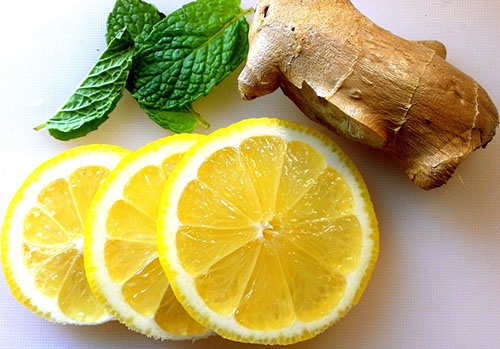 The beneficial properties of mint can be used in such difficult periods of a woman's life as pregnancy and breastfeeding. At this time, the use of medications is extremely limited, and even medicinal herbs should be treated very carefully.
The beneficial properties of mint can be used in such difficult periods of a woman's life as pregnancy and breastfeeding. At this time, the use of medications is extremely limited, and even medicinal herbs should be treated very carefully.
Doctors are confident that daily consumption of up to a liter of mint tea will not harm the health of the mother and unborn child.
Active ingredients in the plant:
- neutralize the manifestations of toxicosis;
- relieve nausea;
- improve appetite and general well-being;
- eliminate signs of causeless anxiety that often accompanies pregnancy.
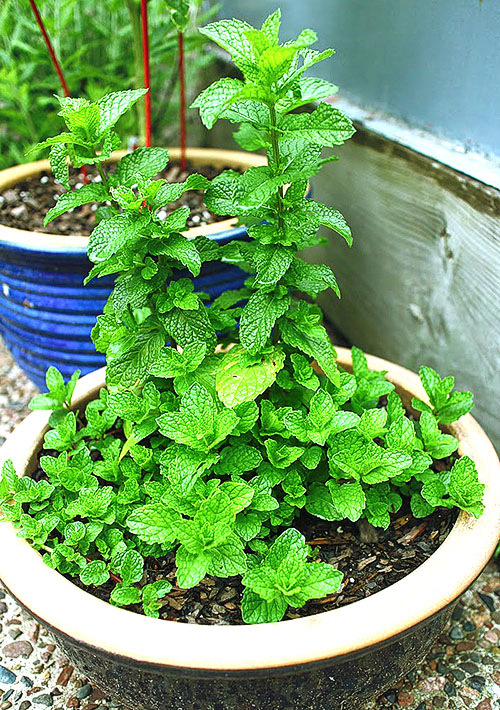 The benefits of mint for the body of the expectant mother also lie in the elimination of heartburn, a mild laxative effect, and the relief of gas. Using medicinal properties mint, women need to take into account the contraindications that exist in relation to this plant.
The benefits of mint for the body of the expectant mother also lie in the elimination of heartburn, a mild laxative effect, and the relief of gas. Using medicinal properties mint, women need to take into account the contraindications that exist in relation to this plant.
If tea and external use of herbal raw materials do not harm health, then essential oil in its pure form during pregnancy is not recommended, since menthol in such a concentration can provoke labor.
 You should not get involved in the use of mint and young mothers. Herbal raw materials of such active action can reduce the amount of milk produced. What else is mint useful for women? A decoction of mint or herbal tea will relieve fatigue, help to cope with menstrual and headaches, and normalize sleep.
You should not get involved in the use of mint and young mothers. Herbal raw materials of such active action can reduce the amount of milk produced. What else is mint useful for women? A decoction of mint or herbal tea will relieve fatigue, help to cope with menstrual and headaches, and normalize sleep.
Useful properties and contraindications of mint for men
 Mint is well known as a tonic, tonic, analgesic and antipyretic plant. And what is the use of mint for men's health?
Mint is well known as a tonic, tonic, analgesic and antipyretic plant. And what is the use of mint for men's health?
- There is no doubt that mint can effectively eliminate the effects of stress, fatigue, mint tea or decoction will calm and set you in a positive mood.
- Regular inclusion of mint in the diet will reduce the risk of developing diseases of the heart and nervous system.
- External application of mint decoction refreshes the skin, reduces sweating and the risk of contracting fungal infections.
With all the beneficial properties of mint, there are contraindications for men that you should listen to. Excessive passion for drinks and dishes with fresh mint, teas based on it or preparations with menthol in a man can cause a decrease in potency, a feeling of relaxation, a decrease in attention, which is especially dangerous when driving.
Contraindications to the use of mint
 With the existing mass of useful properties, mint also has contraindications for everyone who decides to start healing with the help of this plant.
With the existing mass of useful properties, mint also has contraindications for everyone who decides to start healing with the help of this plant.
The first warning is the existence of personal intolerance to substances in the composition of plant materials and preparations from it.
Mint should be used with extreme caution under reduced pressure. In this case, even a cup of seemingly harmless tea can cause an additional decrease in pressure and a deterioration in well-being.
Similarly, mint acts on blood vessels in the thickness of tissues, their tone decreases, blood flow decreases. Therefore, exacerbation of varicose veins is not excluded. With regard to the digestive system, both the benefits of mint and the harm from the thoughtless use of plant-based remedies are possible. For example, with caution take decoctions of mint and with increased acidity, exacerbations of gastritis or peptic ulcer.
Pediatricians do not advise giving mint tea, decoction and other herbal remedies to children under the age of three.
Video about the benefits of mint
(No ratings yet)
Magic Garden
Mint grass - do you know everything about it

I will not be mistaken if I say that everyone knows mint grass. Like many other plants, it got its name thanks to an ancient Greek legend, according to which the lord of the underworld Hades made the beautiful nymph Mentu his concubine. Then the enraged goddess Persephone, in a fit of jealousy for her husband, turned Menta into a nondescript plant. Hades could not remove the spell from the beauty, but he gave her a strong cold aroma. AT ancient world mint grass was extremely popular. It turned out that due to its bactericidal properties, mint grass was used to embalm pharaohs. In the language of most European nations, the name still sounds about the same.
Varieties and varieties of mint
Among the aromatic herbs, mint occupies almost the first place in terms of the number of species and varieties. Spearmint grass was the first to appear in the gardens of pre-Petrine Russia. She has small bright green wrinkled leaves and an elongated loose spike-shaped inflorescence. The leaves emit a pleasant sweetish-spicy aroma, but they do not leave a feeling of cold in the mouth. The inflorescences of this mint herb were the main integral part famous Russian gingerbread. To this day, she is considered one of the the best views for use in cooking. To this day, we collect field mint and use it in herbal preparations for various diseases. Water mint is the progenitor of the peppermint herb known to us. It grows in shallow water and is often used to decorate the coastal part of the reservoir. But the Corsican mint grass is the same one that Persephone trampled. She prefers mountainous rocky terrain.
Restless breeders do not get tired of creating more and more new varieties with variegated, silvery, purple leaves and different aromas. There is mint grass with the aroma of strawberries, pineapple, banana, ginger. These varieties can be grown in pots in the kitchen window or on the balcony. Of all the mints listed, I somehow liked pineapple mint the most. It has a delicate pineapple aroma, and decorative pimply leaves of light green color. I love her so much.
Mint grass. Application
The usefulness of mint herb is difficult to overestimate. Leaves and shoots are added as spicy greens to salads, served with meat. Herb mint will add flavor to compotes, kvass, it is added to bean and lentil soups. Who doesn't love a cup of aromatic mint tea? Mint leaves contain essential oil, menthol, copper, manganese, as well as carotene, betaine, and many others. useful to man trace elements. Mint herb is used for neurosis, insomnia, and diseases of the upper respiratory tract. Mint improves brain function, helps with headaches. Mint has an antitoxic effect, improves digestion.
Growing mint herb is easy. She loves sunny areas, but also tolerates partial shade. The plant is moisture-loving. The roots of mint grass are creeping, shallow, often coming to the surface. Propagated by seeds, dividing the bush.
Mint is a wonderful plant that even has a soothing aroma if you just walk around the garden in the places where it grows.
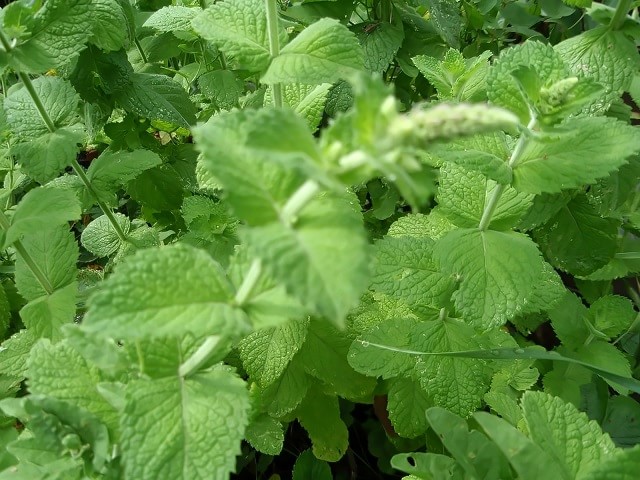


Cultivated herbs: names. Medicinal plants and herbs
Larkspur, liverwort, light grass
Cultural herbs of Russia
The names of herbaceous plants that grow in the vast expanses of our country are extremely numerous. Crops are grown in agricultural fields, the fertile lands of which allow rich harvests. The owners sow and plant on their household plots many herbs.
The most common cultivated herbaceous plant in Russia is wheat. Other cereals widely grown in the country include rye, oats, barley, corn, soybeans and millet.
Popular legumes are peas, beans, lentils.
Potato is the only type of starchy herbaceous plant that is successfully grown in Russia. We also cultivate the only sugar-bearing crop - sugar beet.
Of the oil-bearing species, sunflower, rapeseed, flax, and mustard are widely distributed.
Vegetable plants grow in the fields and in any garden - cucumbers, zucchini, squash, eggplant, tomatoes, dill, radishes, beets, onions, carrots and cabbage. All of the above are also cultural herbs of Russia. Their names are included in the botanical reference book as herbaceous plants. Although it sounds unusual, agree!
Medicinal cultural herbs
Titles medicinal plants, which were cultivated in Russia, are extremely numerous. In total, several million hectares in the country are allocated for sowing medicinal herbs. Most often they sow mint, chamomile, valerian, plantain, burdock, nettle, celandine. Rarely grow lavender, St. John's wort, celery, ginger, motherwort, sage, wormwood, marjoram, basil.

In recent years, the cultivated area under medicinal herbs has been declining rapidly. The main reason is economic inexpediency. Herbaceous plants are demanding in care, crop processing is mainly carried out manually, and raw material prices are low. In addition, many medicinal herbs in subsequent years clog the crops of other crops as weeds, growing again and again in the aisles.
Given the high value of such plants during the Soviet era, they were necessarily included in the crop rotation. Today, however, the farmer sows wheat and sunflowers, the crops that provide the most profit. And who wants to sow sage? Perhaps this is a rhetorical question.

10 Adorable Celebrity Kids Who Look Different Today Time flies and one day little celebrities become unrecognizable adults. Pretty boys and girls turn into s.

How to look younger: the best haircuts for those over 30, 40, 50, 60 Girls in their 20s don't worry about the shape and length of their hair. It seems that youth was created for experiments on appearance and bold curls. However, already

10 Mysterious Photos That Will Shock Long before the advent of the Internet and the masters of Photoshop, the vast majority of photos taken were genuine. Sometimes the pictures got really unbelievable.

7 body parts you shouldn't touch Think of your body as a temple: you can use it, but there are some sacred places that you shouldn't touch with your hands. Display research.

15 Cancer Symptoms Women Most Often Ignore Many of the signs of cancer are similar to those of other illnesses or conditions and are often overlooked. Pay attention to your body. If you notice.

Why do you need a tiny pocket on jeans? Everyone knows that there is a tiny pocket on jeans, but few have thought about why it might be needed. Interestingly, it was originally a place for Mt.
Sushi plants \ Herbaceous plants
herbaceous plants
Perennial plant, 50-150 cm tall. Leaves are palmate, 5-7-parted with a serrated edge. Violet-blue flowers with a petal-shaped calyx forming a domed helmet, under which are 2 elongated nectary petals. The inflorescence is a multi-flowered terminal raceme. The fruit is a trifoliate. Blooms in June-August. It grows in moist forests and upland meadows. decorative medicinal plant, poisonous. In similar habitats, mainly in the mountains, a similar species with yellow flowers grows.

Crow's eye four leaf – Paris Quadrifolia
Perennial herbaceous plant with a long scaly rhizome. Blossoms in May, seeds ripen in July-August. It grows mainly in broad-leaved forests, usually in shady places, as well as in coniferous and mixed plantations, but does not reach good development there. poisonous plant.
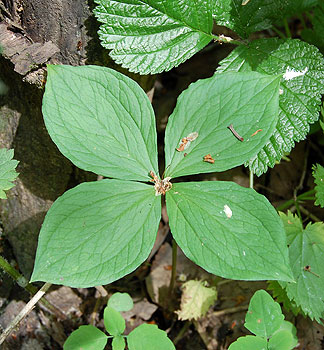

Perennial plant 50-70 cm high, with a thick rhizome and strong dark red stems. Flowers in number 2-3, collected at the top of the stem, bell-shaped, drooping, erect when flowering. Calyx brownish-red. Petals are pinkish, with red-brown veins. Stamens numerous, hairy. Numerous pistils are collected in an ovoid head. Fruits with attachments are distributed with the help of animals and humans. Flowering in May-June, fruiting in June-July. It is confined to meadows, forest edges, shrubs, edges of swamps, banks of water bodies. The rhizomes were used in traditional medicine. From them you can get a red-brown color. The leaves are edible and suitable for salads and soups.

Wintergreen round-leaved – Pyrola rotundifolia
Wintergreen perennial with a long branched rhizome. The leaves are basal, with long petioles and leathery, shiny, rounded plates. A flower-bearing shoot up to 30 cm high, ends with an 8-15-flowered inflorescence-brush. Corolla widely open, white, up to 2 cm in diameter. The fruit is a flattened-spherical box. Blossoms in June-July, seeds ripen in August-September. Propagated by seeds and vegetatively, by growth of rhizomes; in optimal conditions forms large patches. Grows in coniferous and coniferous-small-leaved forests.

A biennial or perennial monocarpic plant that dies off after fruiting. The stem is hollow, up to 200 cm high, with a bluish coating, with a few branches in the upper part. The leaf blades are triangular in outline, double- or triple-pinnately dissected. Violet "belts" at the point of origin of the petioles of the lateral segments are very characteristic. Petals are white or pinkish on the outside. The fruits are brown. Blooms from mid-summer to late autumn, fruits ripen from August. It grows in damp forests, clearings, clearings, edges, grassy swamps, along the banks of reservoirs. Good honey plant.
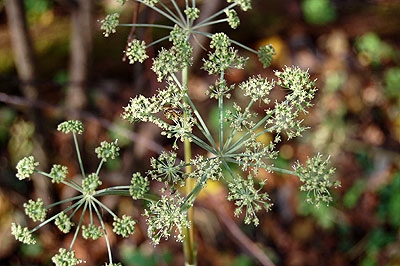

Perennial herbaceous plant from 8 to 35 cm high, with long creeping rooting shoots and erect flowering stems. The leaves are oval. The flowers are blue or blue, at the top of the stem form a dense spike-shaped inflorescence. Blossoms in May-July, fruits ripen in June-August. Grows in forests, mostly deciduous, on edges, clearings, in thickets of bushes. Honey plant.
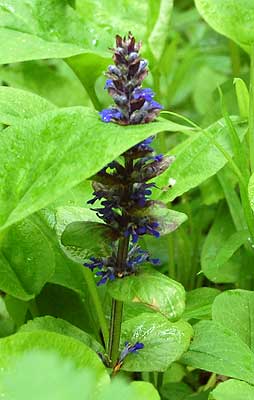
chickweed hard-leaved – Stellaria holostea
Perennial herbaceous plant, 15-40 cm tall, with creeping branched rhizome. Stem quadrangular, erect. Leaves sessile, linear or linear-lanceolate, with a long pointed tip. Petals are half as long as sepals. Blooms in April - June. It grows among shrubs, in deciduous forests, along forest edges.

An annual or overwintering plant 5-30 cm high, strongly branching, with decumbent, weak, thin stems. Flowering from April to October, fruiting from July. Widely distributed throughout Russia. It grows in damp shady forests, in vegetable gardens, gardens, parks, fields, roadsides, near dwellings, along the banks of reservoirs, ditches, damp deposits and wastelands. One of the most widespread weeds.


Perennial plant, 15-45 cm tall. Shoots erect or ascending. Leaves are crenate; lower - with long petioles, obtuse, heart-shaped - ovoid, upper - with shorter petioles, sharp. The flowers are yellow, with red spots on the lower lip. Blooms in May - June. In damp forests and bushes.

A perennial plant with an upright stem 10-50 cm high. At the base of the stem, thin filamentous shoots often develop, forming fleshy bulbs by autumn. Leaves are linear. Petals are pale pink or whitish. The fruit is a box. Blooms from June to autumn, seeds ripen from July. Grows in damp places: swampy forests and meadows, banks of water bodies, sandy and peat flooded quarries.
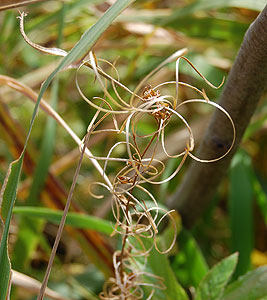

Oxalis ordinary – Oxalis Acetosella
Perennial plant 5 - 10 cm high, with a creeping rhizome, covered with pink scales. Leaves basal, trifoliate, with long petioles; leaflets are heart-shaped, folding along, thin. Flowers solitary, on peduncles exceeding the leaves. The corolla is white, with purple veins, rarely the petals are lilac-pinkish or purple. The fruit is an ovoid wrinkled light brown capsule. Blossoms in May-June, fruits ripen in July-August. It reproduces vegetatively, by growth and branching of rhizomes, and by seed. When ripe, the bolls crack and the seeds are scattered; The seeds are dispersed mainly by ants. Grows in damp forests, mostly dark coniferous, often dominates and forms a continuous cover. Used as a food plant: the leaves contain vitamin C and oxalic acid, have a sour taste and are used in soups, salads, seasonings and teas. The leaves have antiscorbutic properties.

European hoof – Asarum europaeum
Evergreen perennial herbaceous plant with cord-like creeping rhizome and creeping rooting branched stem. The seeds are spread by ants. The plant has a specific smell. Blooms in April-May; seeds ripen in June. It spreads by seeds and vegetatively - by the growth of rhizomes; while the hoof often forms large patches. In coniferous, broad-leaved forests and coniferous-deciduous shady forests. Poisonous plant. Preparations from rhizomes and leaves have long been used in folk medicine and veterinary medicine. Ornamental plant, can be cultivated as a groundcover.

Perennial plant with creeping or arcuate curving and rooting vegetative shoots and erect flower-bearing stems about 20 cm high. The leaves are trifoliate, with long petioles. The flowers are white, five-membered, collected 3-10 in apical umbellate or racemose inflorescences. Fruitlets are few drupes (usually 1-6), large, bright red, barely interconnected. Flowering in May-June, fruiting in June-July. The fruits are eaten raw and processed (juices, fruit drinks, jam). Honey plant.
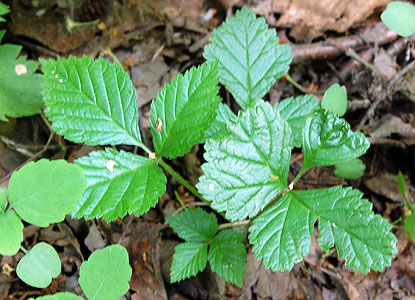
Perennial herbaceous plant up to 1.5 m high, with long horizontal rhizomes. The plant is dioecious. Flowering and fruiting all summer. Propagated by seeds (one plant produces up to 22,000 seeds) and vegetatively. Forms extensive dense thickets. It grows near dwellings, roads, hedges, wastelands, etc. soils rich in nitrates. It is typical for disturbed damp forests, especially alder forests, banks of reservoirs and ravines, drained peat bogs, neglected gardens. Valuable food and medicinal plant. From young leaves and shoots, green cabbage soup is cooked in spring. As a therapeutic and prophylactic agent, they are used for hypo- and beriberi. Nettle preparations are used as a hemostatic and wound healing agent, are part of choleretic preparations. In folk medicine, it is also used as a means to strengthen hair. A valuable fodder plant, especially for pigs and poultry. Boiled young nettle shoots increase the milk yield of cows and increase the percentage of fat in milk. From the stems, fiber can be obtained for the manufacture of ropes and coarse fabrics. The leaves and rhizome were formerly used to make green wool dye.

burdock – Arctium tomentosm
Biennial plant 60-100 cm high, with a fleshy spindle-shaped root. The stems are powerful, green or reddish, furrowed, strongly branched, cobwebby pubescent under the baskets. The leaves are large, ovate. Baskets with cobwebbed wrappers, in a common corymbose inflorescence. Purple corolla. The fruits are grayish-brown or brown faceted achenes with a short crest. Blossoms in June-August, fruits ripen in July-September. Grows in waste places settlements, in landfills, in ravines, along the banks of reservoirs, on borders, roadsides. From the roots, the so-called "burdock oil" is obtained, which is used to strengthen the hair on the head. Young fleshy stems, freed from the skin, are edible.

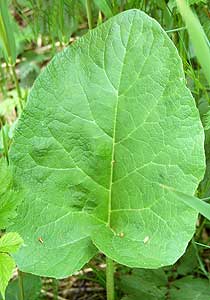
Perennial herbaceous plant 10 to 40 cm high, with creeping rooting shoots. The stem is thick, juicy. Leaves are long-petiolate, trifoliate, leaflets with petioles. Flower with five protruding sepals, 5 golden yellow petals, numerous stamens and pistils. The fruit is a polynut. It blooms from spring to the end of summer, respectively, the fruits ripen in different time. AT middle lane this is a common plant of damp meadows, swamps, sparse forests, dirt roads. Poisonous plant.
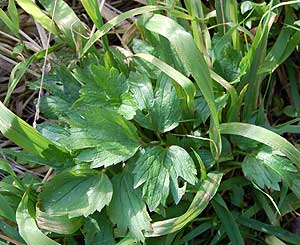

Lungwort obscure – Pulmonaria obscura
Perennial herbaceous plant 8 to 30 cm high. Flowers with pink at the beginning of flowering, later turning blue corolla. Blossoms in April - May, fruits ripen in May - June. Grows in forests, ravines, bushes. Decorative early spring plant. Good honey plant. The leaves are rich in ascorbic acid and other vitamins, edible, suitable for salad.
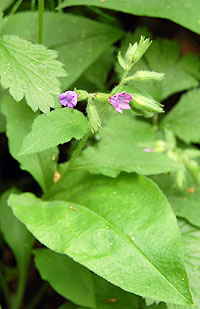
Soft hair aquatic – Myosoton aquaticum or Malachium aquaticum
Perennial herbaceous plant up to 120 cm high, pubescent at the top with glandular hairs. Stem creeping, ascending. The leaves are tender, sessile, cordate-ovate, pointed. Inflorescence forked, umbellate. White flowers with bipartite petals. Blooms in June-September. It grows along the banks of reservoirs, in shrubs and light floodplain forests.
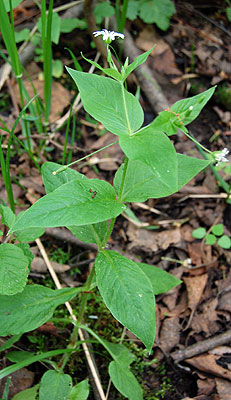
Perennial herbaceous plant 15-45 cm high. Leaves ovate or oblong. Whorls spaced, inflorescence discontinuous. The calyx is often purple. Corolla lilac or lilac-pink. Blossoms in June-September, fruits ripen in July-September. It grows along the banks of water bodies, ditches, damp meadows, damp forests and other diverse damp habitats. Contains essential oil, has a specific smell, is used as a spice in cooking and when pickling vegetables.
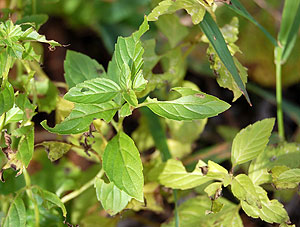
forget-me-not marsh – Myosotis palustris
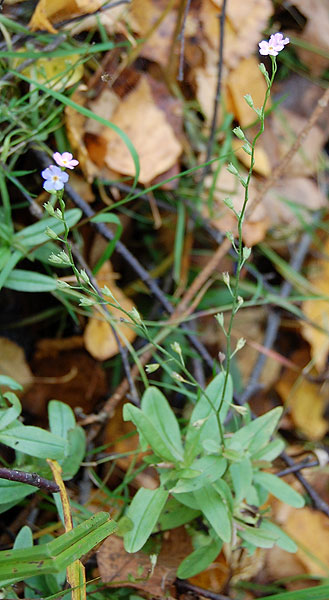
Perennial herbaceous plant 15-80 cm high. Leaves lanceolate or linear-lanceolate. The flowers are collected in apical inflorescences - curls. Corolla blue, rarely pinkish or white. The fruits are black. It blooms from May to September, the fruits ripen throughout the summer and autumn. Grows in wet meadows, grassy swamps, along the banks of reservoirs. Most Popular ornamental plant collected for bouquets. Honey plant.

Forget-me-not dense – Myosotis nemorosa
Found near keys and exits ground water, damp forests and thickets of bushes, swampy ruts of forest roads. Flowering - June-July.

Daisy – Leycanthemum vulgare
Perennial herbaceous plant with a short rhizome, slightly faceted stem 15-60 cm high and a basal rosette. Rosette leaves are spatulate, crenate along the edges with long petioles; stem - oblong, serrated along the edges, sessile. Inflorescences - baskets, single, large. Marginal false-lingual flowers in baskets are very long, white, do not form seeds. The median tubular flowers are yellow in color, give normal achene fruits. Blossoms in May-August, fruits ripen in June-September. Grows in meadows, forest clearings, forest edges, roadsides, sparse forests, clearings. Thanks to large inflorescences, it often creates an aspect in meadow communities and gives them bright picturesqueness. Among the people throughout Russia, leucanthemum is usually called "chamomile".

Perennial plant, 20-45 cm tall, with erect stem. Leaves without tendrils, with 2-4 pairs of broadly ovate, with long pointed tips, glossy leaflets 3-7 cm long. The flowers are purple, later turning blue, and then bluish-green, usually collected 4-6 in racemes on long peduncles. Blooms in April-May. Blooms first of the legumes. It usually grows in shady deciduous forests with abundant herbaceous cover, in shrub thickets, mainly on calcareous soils. Less common in northern regions.
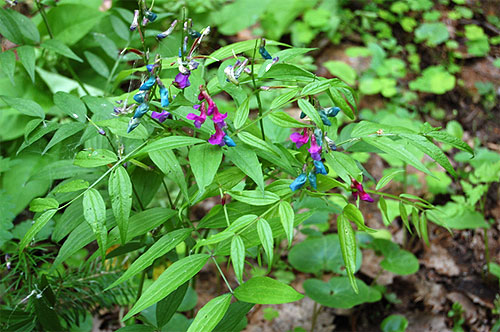
Common colza – Barbarea vulgaris

Biennial 20-70 cm high. The lower leaves are lyre-shaped, with a larger oval terminal lobe than the side ones. The upper leaves are oval, notched-toothed. The flowers are collected in a dense brush. Blossoms in May - June, bears fruit. It grows in meadows, forest edges, as a weed in fields, vegetable gardens, gardens, along roads, in villages. Good honey plant.

Perennial herbaceous plant 80-250 cm high, containing milky juice, with a short thick rhizome, from which cord-like roots extend. The leaves are swept at the base, with pointed ears, pinnately dissected. Baskets are many-flowered, located singly at the tops of stems and branches or form a corymbose-paniculate common inflorescence. All flowers in the basket are reed, bisexual, yellow in color. The fruits are tetrahedral achenes. The tuft is whitish, easily falling off. Blossoms in June-July, fruits ripen in July-August. It grows on the banks of water bodies, swamps, saline areas in floodplains, in thickets of shrubs in wet habitats.
meadowsweet or Meadowsweet – Filipendula ulmaria
large perennial up to 2 m high, with a short rhizome. The leaves are intermittently pinnate, glabrous above, dark green, below with fine white-tomentose pubescence, with a pungent odor when rubbed. Numerous flowers are collected in a dense paniculate inflorescence. Petals are yellowish white. The fruits are single-seeded non-opening leaflets. Flowering in June-July, fruiting in July-August. Grows in wet meadows, grassy swamps, edges of swampy forests, along the banks of reservoirs and ditches. It is rich in tannins and is suitable for tanning and dyeing leather. It has long been used in folk medicine. Young shoots are used as a salad. Good honey plant.

Chernobyl or Wormwood – Artemisia vulgatris
Perennial herbaceous plant 50-200 cm high. The stem is brownish-violet in color, abundantly leafy throughout its height. The leaves are double- or triple-pinnately dissected, with wide terminal segments. Baskets in loose panicles. Blooms from June to September, fruits ripen in July-October. A common plant of garbage places in settlements, roadsides, wastelands, landfills. It also grows on the banks of reservoirs, marginal fields, in ravines. Used in folk medicine. Brooms are knitted from above-ground shoots.
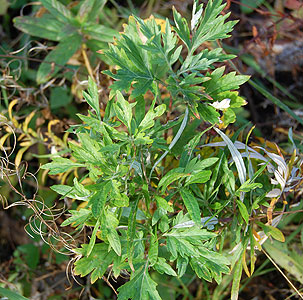
Three-part series – Bidens tripartite
An annual plant, 15-100 cm tall, with a branched brownish-red stem. The leaves are opposite, usually 3-parted, dark green, petiolate, serrate. Baskets - at the end of the stem and opposite branches, erect. Flowers yellowish-brown, tubular. Blooms in June-September. It is common in damp places, on arable land and along the banks of reservoirs, ditches and swampy places.
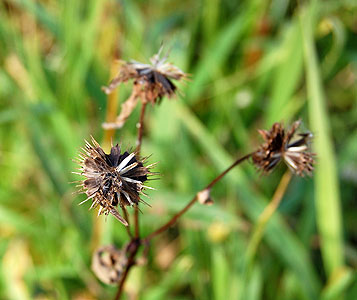
A perennial plant reaching a height of 90 cm. The stems are erect, branched. The leaves are green above, gray below. Bright yellow flowers are collected in an umbrella-shaped inflorescence. The fruits are thin pod-shaped capsules, with numerous black-brown seeds. All parts of the plant contain an orange milky sap. Flowering from May to August, fruits ripen from July. It reproduces by seeds, which are spread by ants, and are also carried along with the earth sticking to shoes, agricultural tools, hooves, etc. It grows in garbage places, along roads, fences and dwellings, in ditches, neglected gardens and parks, disturbed forests. A plant that has long been used in medicine and veterinary medicine (in particular, the plant acquired its name due to the burning milky juice, which people have long been used to remove warts and other skin growths). Also used as insecticide- dried grass powder is used to pollinate cultivated plants to protect against garden pests. Juice was used for blackening metals, grass - for dyeing wool in red and yellow tones. The plant is poisonous.
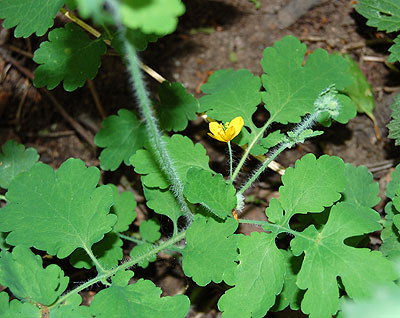
Common sorrel – Rumex obtysifolius
Perennial plant, 60-100 cm tall. Basal leaves are cordate-ovate, long, petiolate. Like all representatives of this genus (rumex), flowers with 6 tepals are usually small, greenish, inner tepals are distinctly serrated. The inflorescence is broadly paniculate, the flowers are in whorls apart. Blooms in June-August. The fruit is a trihedral nut surrounded by overgrown tepals with teeth and nodules. It grows in meadows, clearings, along ditches and on roadsides.

Laminaria speckled – Laminum maculatum
Perennial plant, 15-60 cm tall, with erect shoots. Leaves are heart-shaped-ovate, acute or pointed, crenate or serrate. The fruits are brown. The flowers are light purple, on the lower lip with dark speckles. Blooms from April to autumn. In deciduous forests and shrubs; less common in the north. Good honey plant. The young leaves are edible and are used to make soup.

MOU OOSh, village of Pushkino, Yaransky district, Kirov region
5-11 CLASS
Three groups of plants: herbs, trees, shrubs
All plants can be divided into three large groups: herbs, trees, shrubs.
Herbs(herbaceous) - plants that have soft and thin stems.
- annuals - plants that have time to grow from a seed in one summer and bear fruits and seeds.
- biennial - plants that form roots, stems, leaves in the first year. In the second year they bloom and bear fruit.
- perennials - plants that live for many years.
Trees- plants that have perennial woody stems.
They have a main stem - a trunk. Lateral stems are branches.
- deciduous - refers to deciduous species.
- conifers - belong to conifers (instead of leaves - needles).
shrubs- plants that have tree-like stems, but do not have a trunk.
Shrubs- plants whose stems are not herbaceous, but woody, strong.
Subshrubs- plants in which only the lower parts of the stems become woody, harden, and the upper ones remain soft, herbaceous.
